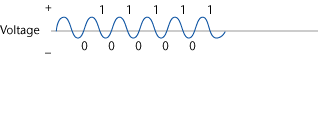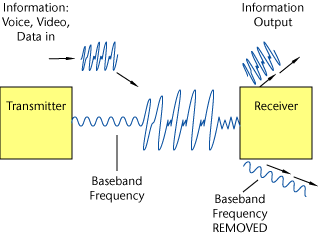To send a voice message, an image, or information across telecommunications lines or airwaves requires that the data be converted into a form that can be carried on an electrical current or radio wavelength. The two methods used for this conversion are analog and digital signal transmission.

Analog Communications
To transmit information in an analog format, the data, image, or voice is converted into an analog waveform, which electrically emulates the input signal. This waveform is then applied to a constant baseband frequency, which is generated by the transmitter. When the signal reaches the receiver, the baseband frequency is filtered out, leaving the analog waveform, which is then converted by the receiver back into its original form of voice or sound, data, or images.Analog communications have been used since the beginning of electrical communication, and are used in common CCTV systems, where the video images are carried over coaxial electrical cables.
Although functional, analog communications can be distorted by outside interference, which can result in a poor quality of signal or image. Analog signaling is also prey to attenuation over distance, with signals losing power and quality as they travel through the air or over an electrical cable.
To transmit over long distances, analog communications can require large amounts of electrical power, such as the 50,000 watt AM radio stations that were established in the early 1900s.
Distortion, attenuation, and large power requirements limit the uses and distances at which analog communications are practical. However, analog is perfectly acceptable for short-distance use, as is demonstrated by virtually any standard CCTV installation.

Digital Communications – Zeros and Ones
A better way to transmit signals was realized with the development and adoption of digital communications.Signals to be transmitted are first converted into a string of 0s and 1s, which correspond to specific voltage changes.
These voltage changes are then applied to the “baseband†frequency, and sent to the receiver, which removes the baseband wavelength and converts the 0s and 1s back into the original message.
By converting images, voice, or data into a “binary†code consisting of a string of 0s and 1s, many of the problems inherent in analog communications can be sidestepped.
While electrical interference from magnetic or radio frequency sources can cause great distortion in an analog signal, it can have less effect on digital communications, as increased “peaks†caused by distortion can still be interpreted by the receiver as 0s and 1s.
Digital signaling provides for longer-distance transmission potential, as the lessening of the signal over distance can still provide a clear distinction between the 1s and 0s.

Signal Power
Because the voltages signifying the 1s and 0s are of set values, the power needed to transmit digital signals is inherently less than that of analog signals, where the larger peaks of the waveform would require more power to be transmitted.With lower power requirements, longer transmission distances, and less susceptibility to electrical interference, digital communications are superior to analog, and provide the basis for network communications.



